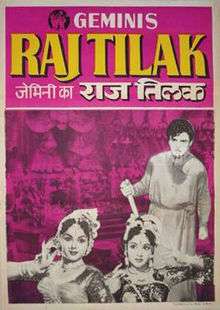Raj Tilak (1958 film)
Raj Tilak (Hindi: राज तिलक; Crown Prince) is an Indian Black-and-white Ruritanian romance epic film in Hindi language made in 1958 written by the Gemini Studios story department, consisting of K. J. Mahadevan, C. Srinivasan and Kothamangalam Subbu, along with Ramanand Sagar, while the film was directed and produced by S. S. Vasan.[1] The film features Vyjayanthimala, Padmini and Gemini Ganeshan in the lead, along with Pran, Gajanan Jagirdar, Bipin Gupta, Meenakshi, Lalita Pawar, Durga Khote, Manmohan Krishna and Shammi, forming an ensemble cast.[2]
| Raj Tilak | |
|---|---|
 | |
| Directed by | S. S. Vasan |
| Produced by | S. S. Vasan M. A. Partha Sarathy |
| Screenplay by | K. J. Mahadevan Ramanand Sagar |
| Story by | Kothamangalam Subbu K. J. Mahadevan Ramanand Sagar |
| Based on | The Count of Monte Cristo by Alexandre Dumas |
| Starring | Vyjayanthimala Padmini Gemini Ganeshan Pran |
| Music by | C. Ramchandra |
| Cinematography | P. Ellappa |
| Edited by | N. R. Krishnaswamy |
Production company | Gemini Studios, Madras |
| Distributed by | Gemini Pictures |
Release date |
|
Running time | 171 minutes |
| Country | India |
| Language | Hindi |
The screenplay was done by Ramanand Sagar, who had earlier worked with S. S. Vasan in Insaniyat.[3][4] The film was a remake of 1958 Tamil film Vanjikottai Valiban.[5]
Cast
- Cast according to the opening credited of the film
|
|
Table of Vanjikottai Valiban and Raj Tilak
| Vanjikottai Valiban (Tamil) | Raj Tilak (Hindi) |
|---|---|
| Sunderalingam (Gemini Ganeshan) | Chander (Gemini Ganeshan) |
| Mandakini (Vyjayanthimala) | Mandakini (Vyjayanthimala) |
| Padma (Padmini) | Padma (Padmini) |
| Chokkalinga Navalar (T. K. Shanmugam) | Sardar Mangalsen (Jagirdar) |
| Navalar's Wife (Kannamba) | Sardar Mangalsen's Wife (Durga Khote) |
| Murugan (S. V. Subbaiah) | Madho (Manmohan Krishna) |
| Ragamma (M. S. Sundari Bai) | Alka (Lalita Pawar) |
| Senapathi (Veerappa) | Senapati Durjay Singh (Pran) |
| Kothaval (T. K. Ramachandran) | Gajpal (T. K. Ramchandar) |
| Gowri (Vijayakumari) | Savithri (Vijayakumari) |
| Princess (Meenakshi) | Maharani (Meenakshi) |
| Prince (Master Murali) | Prince (Master Romi) |
| King of Rathna Island (R. Balasubramaniam) | Maharaj Vikram Singh (Bipin Gupta) |
| King (D. Balasubramaniam) | Ship Captain (Kumar) |
| Velan (Thangavelu) | Govind (Agha) |
| Velan's Wife (Muthulakshmi) | Govind's Wife (Shammi) |
Soundtrack
The music was composed by C. Ramchandra and the lyrics were written by P. L. Santoshi.
| Song | Singer |
|---|---|
| "Dil Jo De Doongi Raja Nikaalke" | Lata Mangeshkar |
| "Aaj Na Jaane Reh Reh Kyun Dil Yeh Mera Dole" | Lata Mangeshkar |
| "O Jaane Jigar, Zara Dekho Idhar" | Asha Bhosle |
| "Aaja Tu Aaja Raja, Mausam-e-bahaar Hai" | Asha Bhosle, Sudha Malhotra |
| "Chalna Sambhal Sambhal Ke Ji" | Asha Bhosle, Mohammed Rafi |
| "Ho Re, Dekho Aayi Re O Kali Ghata" | Mohammed Rafi |
| "O Maa, Naa Bolegi, Naa Bolegi" | Manna Dey |
| "Bam Bholanath, Bam Bhola" | Manna Dey |
Reception
According to the writer Ashokamitran, Raj Tilak was "the biggest flop Gemini ever made".[6]
Inspirations and remakes
The film was a remake of 1958 Tamil film Vanjikottai Valiban, which also directed by S. S. Vasan with Gemini Ganesan, Vyjayanthimala and Padmini.[5] The film itself was inspired by the 1844 novel The Count of Monte Cristo by Alexandre Dumas.[7]
References
- Randor Guy (23 May 2003). "With a finger on people's pulse". The Hindu. Retrieved 8 January 2012.
- Subhash K. Jha (Indo-Asian News Service) (1 April 2010). "Southside Male Bollywood". IndiaGlitz. Retrieved 8 January 2012.
- Subhash K. Jha (Indo-Asian News Service) (13 December 2005). "Ramanand Sagar: TV and cinema's blockbuster man". IndiaGlitz. Retrieved 8 January 2012.
- "Ramanand Sagar: A writer's sensibility". The Tribune. 25 December 2005. Retrieved 6 March 2012.
- Randor Guy (26 March 2011). "Vanjikottai Vaaliban 1958". The Hindu. Retrieved 8 January 2012.
- Ashokamitran (2016). Fourteen Years with Boss. Penguin Books. p. 134. ISBN 978-0-14-342329-4.
- Ramachandran, T.M (1985). 70 Years of Indian Cinema 1913 to 1983. I B D Ltd. p. 78. ISBN 978-0-86132-090-5. Retrieved 4 June 2011.